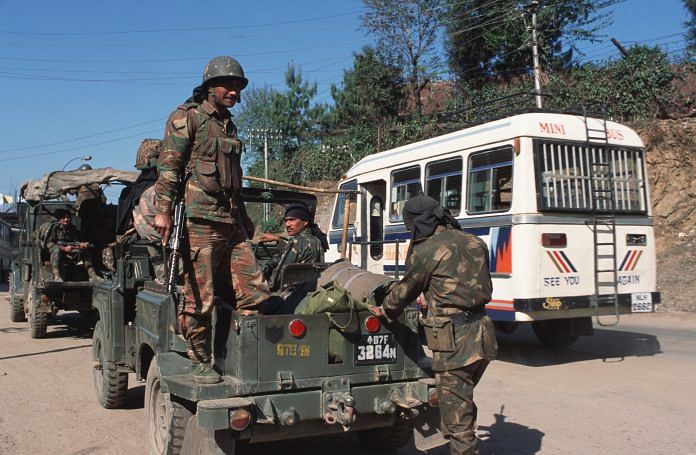The operation in January 2000 was launched in PoK in retaliation to an attack from across the LoC.
New Delhi: Much before the 2016 surgical strikes against Pakistan, the Indian army carried out several small and big operations inside Pakistan-Occupied Kashmir, right from the 1990s up to 2013.
One such major operation was carried out in January 2000 under the leadership of then Army chief Gen. Ved Prakash Malik.
During this strike, in which about 100 Indian soldiers were involved, as many as 16 Pakistan army soldiers were killed.
Gen Malik, now retired and living in Chandigarh, confirmed that such an operation had indeed taken place in 2000.
“Yes, some people were given gallantry awards for their action,” Gen. Malik told ThePrint, adding, “But I will not say any more on the subject.”
It is believed the gallantry awards even include a Vir Chakra, indicating that courage beyond the call of duty had been displayed by the Indian soldiers during the strike inside PoK.
Malik would not say why and whether the Indian army operation took place in retaliation against a Pakistani attack.
But defence analysts recalled that the year 1999 had ended with the hijacking of the Indian Airlines flight IC-814, and that the summer of 1999 had concluded with the conflict in Kargil. Malik had been army chief through that period.
An Indian Army officer, speaking on condition of anonymity to ThePrint, confirmed the January 2000 strike.
“Indian soldiers attacked a Pakistan Army post after midnight from three directions in the Iftikharabad sub-sector in the Chhamb sector across LoC with own artillery support. This incident was duly acknowledged by Pakistani authorities as well,” the source said.
However, he added, unlike the September 2016 strikes that were immediately made public by the Narendra Modi government, all the previous operations were carried out under cover of secrecy.
For the first time, however, defence analysts are now willing to go public about some details of these operations.
Fed up with the publicity accompanying the 2016 surgical strike videos released earlier this week — which the BJP has also used to make its own video — these analysts say their reason for going public is because they fear the politicisation of the army is underway.
Pravin Sawhney, editor of FORCE, a newsmagazine on national security and defence, confirmed that in the January 2000 covert operation as many as 16 Pakistani soldiers were killed.
“These soldiers were not from the Special Forces, but Ghatak platoons of regular infantry units, which struck the Pakistan army post in the Chhamb sector. It was coordinated at the brigade level. The operation killed 16 Pakistani soldiers, not terrorists, who are dispensable,” Sawhney told ThePrint.
The Ghatak Platoon is part of a regular infantry battalion with special operations capabilities. There is one such platoon in every infantry battalion of the Indian Army.
“Aside this strike, there were several other strikes carried out by the Indian armed forces across the LoC, in locations closer to Akhnoor, Kotli, Nowshera, Pallanwala, among others between January and August, 2000, which had led to the casualty of anywhere between five and seven Pakistani soldiers,” Sawhney added.
“In military parlance, none of these operations qualify as surgical strikes. A surgical strike has to have legitimate military targets and also achieve some extraordinary results, which will force some rethinking within the Pakistan army.
“Since in the 2016 strike there were significant terrorist casualties, these could at best be termed a highly coordinated military raid,” Sawhney added.
“It baffles me that Gen Hooda would call the 2016 strikes to be the first. It is unfortunate that an Army mission is being changed into a political mission,” he said, referring to the Northern army commander who monitored the strikes from Udhampur when they took place in 2016.



